Love in Laos
By Lydia Sun (孫沛芬)
Photos by Huang Hsiao-che (黃筱哲)
Abridged and translated by Syharn Shen (沈思含)
Love in Laos
By Lydia Sun (孫沛芬)
Photos by Huang Hsiao-che (黃筱哲)
Abridged and translated by
Syharn Shen (沈思含)
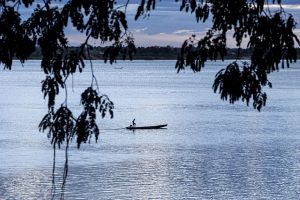
The Mekong River flowing by Pakse in Champassack Province is calm and wide, with Thailand on the opposite bank. The Mekong runs through China, Myanmar, Laos, Thailand, Cambodia, and Vietnam, serving as a natural border between Laos, Myanmar, and Thailand. At many sections, the river cuts through deep valleys, forming rapids and fast currents.
I've never set foot on this country before. Years ago, a friend I met on a bike journey around Taiwan said about this land: "You may have never thought of visiting this country, but when you do, you'll fall in love with it."
My friend was speaking about Laos.
The Charms and Dangers of the Mekong
It was the end of November in 2019. I arrived in Laos together with a group of Tzu Chi volunteers. They were there to bring aid to flood survivors; I went along to film as a Da Ai TV staff. When we reached Pakse, there was a temple festival to offer thanks to a god revered by local overseas Chinese. Throngs of worshippers lined before the Chinese temple located on the banks of the Mekong River, taking part in the lively festival that attracts crowds every year.
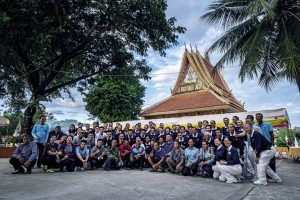
Together with local volunteers, Tzu Chi volunteers from Taiwan, Cambodia, Thailand, Malaysia, Vietnam, and Myanmar have distributed supplies and rice seeds to over ten thousand households affected by the floods.
The bustling temple stands in stark contrast with the calm and quiet Mekong River nearby. I walk to a tower on the bank for a view of the grand river flowing serenely. From dawn to dusk, the Mekong remains ever graceful as it morphs into a myriad forms with changing light and weather conditions. Yet, her sudden change in temper can also turn extreme during the rainy season.
In August and September of 2019, tropical storms Podul and Kajiki brought heavy rains that caused widespread flooding in southern Laos. The Mekong overflowed, inundating six provinces and leaving over five hundred thousand people affected. The rains and floods during the wet season—from May to October—usually bring nourishment to the river basin, but in 2019, the floods did not recede. It was hard for me to imagine the beautiful river wreaking havoc across the land.
As the only landlocked country in Southeast Asia, Laos seems to be destined for flooding whenever rainstorms strike. After the disastrous floods in 2019, Tzu Chi volunteers from six countries arrived to Laos to distribute aid to flood survivors. Travelling with the team, I got to witness in person the state of the country after the wreckage.
Before the aid distributions, the supplies had to be transported to different locations. Once, a large truck loaded with supplies arrived at a dock in Champasak Province, ready to cross a tributary of the Mekong. But, the truck was too large to board the ferry. We waited for two hours for the supplies to be moved to a smaller truck that could fit on the boat. My colleague and I took another ferry behind, filming the truck of supplies crossing the river. All the way, I couldn't keep my eyes off the supplies on the ferry until we landed safely ashore.
When we arrived at the village across the river, the conditions were appalling. It was nearly four months after the flooding, and the destroyed houses were in the same state as pictured in a photo taken by a Tzu Chi volunteer shortly after the floods hit. Seeing the devastation with my own eyes, my heart ached for those affected.
An old woman told us that she often stared blankly at her collapsed house, wishing that it was all just a nightmare. Tugging at the clothes she was wearing, she said that everything had been swept away by the floods. There was nothing left. No money, no clothes. She even had to rely on her neighbor's help to have something to wear. With no food or clothing, the local survivors cannot even think of rebuilding their homes.
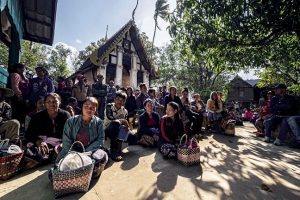
At a Buddhist temple over three hundred years old in Savannakhet Province, flood survivors wait in peace and silence to receive relief supplies from Tzu Chi.
On the last day of November, we came with Tzu Chi volunteers to this village again to hand out aid supplies. We set out at about 5 a.m., crossed the river, and got ready for a distribution at a hydroelectric power station. By the streets, we saw local people with food in their hands and waiting on their knees. It wasn't until later that we realized they were waiting to offer food to Buddhist monks who came out to beg for alms each morning. The orange robes of the monks and the blue-and-white uniforms of Tzu Chi volunteers displayed a lovely array of colors that symbolized spiritual relief and material aid to the local people.
Of the ten Tzu Chi's distributions in Laos from the end of November to early December in 2019, eight were held in Buddhist temples. One distribution was held in a temple over three hundred years old in Savannakhet Province. A center of faith for the local people, the temple was also devastated by the floods, bearing visible marks on its walls that showed the severity of the disaster. The small Buddhist statues enshrined in the temple were swept away by the waters. Only a large statue of the Buddha remained guarding the temple.
The Charismatic People of Laos
"Sabaidee" is a phrase that one must learn when visiting Laos. It means "hello" and is the standard greeting used day and night.
Growing up in a Theravada Buddhist culture, the people of Laos are cordial and gentle. When greeted upon, children and adults alike always greet back with a smile and their hands pressed together. Even without any knowledge of the Lao language, one can make friends with the locals just by using "sabaidee" and communicating with gestures.
In addition to their friendliness, the locals' tranquility and discipline left a deep impression on me. During the distributions, villagers were divided into different groups to take turns and receive aid supplies. When members of a group arrived early, they had to wait at a designated area where volunteers would explain the distribution process or lead activities. Everyone who arrived simply sat quietly and would not get rowdy, even after waiting for a couple of hours. I truly felt the peaceful and disciplined character of the Lao people.
When Tzu Chi volunteers led everyone to sing with sign language, the locals, shy at first, would start to move along the music. A grandma holding a sign at one of the distributions swayed to the rhythm of the songs. Another grandma who just received supplies, seeing that I was filming, started doing exotic dance movements. Dance and movement seemed so natural to them.
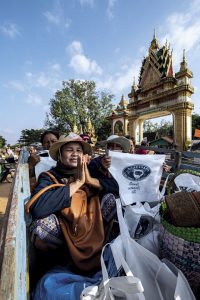
After receiving Tzu Chi's aid supplies that include rice, oil, salt, sugar, and rice seeds, a villager puts her palms together in gratitude.
At a distribution in a temple in Champasak, a Dharma master who saw us filming also took a camera to film us. It was very amusing. "I want to record Tzu Chi volunteers helping the local people in Laos. Their support is very touching!" he said.
The sincerity and charisma of its people made me fall in love with Laos.
A Lack of Food and Clothing
My experience at a homestay in Savannakhet Province was a most memorable one. During the two days that we stayed there, our team was likely the only guests at the place. The beds were simple and the flow of hot water was minimal. In the evening, there was no food to eat, and there were no shops or villages nearby to buy food either. We were also cold and shivering as it was 16°C. We didn’t bring any warm clothes as we thought it would be summertime all year round in Laos.
For our dinner, a Tzu Chi volunteer from Malaysia asked the owner of the homestay to drive us to a market far away to buy instant noodles and vegetables. It was a pot of noodles with vegetables that I will never forget. Everyone was crammed in the small kitchen, surrounding the steaming pot. My freezing body soon became warm. It was the best pot of instant noodles that I have ever had.
The hunger and cold that we experienced was nothing compared with the situation that the flood survivors had to endure. As we travelled by the countryside during daytime, we saw that crops on the flood-ravaged fields were completely destroyed. There was nothing left but yellow dirt. On a four-wheel car, we had a bumpy ride through the winding and narrow country roads of Savannakhet Province before arriving at a village deep in the forest to distribute aid supplies.
After the floods, the rice field of a local farmer named Khem has dried and cracked. As it was the dry season and there were no means for irrigation, he could only wait for the rainy season starting in May to plant rice again. Among Khem's ten kids, nine of them do odd jobs, but what they earn is not enough to feed the large family. Khem's greatest hope is to cultivate on his field again.
To help farmers in the severely hit provinces of Savannakhet and Champasak, Tzu Chi volunteers handed out sixty kilos of rice seeds for one hectare of land. In addition, every farmer received twenty kilos of rice, a kilo of sugar, half a kilo of oil, and half a kilo of salt. Having received the rice seeds and food supplies, Khem says he is no longer worried that his family will go hungry and can prepare his land for planting again before the rainy season arrives.
The floods had brought harsh trials to the people of Laos who already live in lack and poverty. Despite the dire conditions they are in, the local people accept the blow dealt by fate and face challenges in life with courage and resilience.
A Country Ready for Development
My biggest slipup in preparing for the trip to Laos was my miscalculation of the local temperatures. In the capital city of Vientiane, temperatures during the daytime reached close to 30°C, but when night fell and dawn arrived, the temperatures would dramatically drop to around 10°C.
One day at 4 a.m., my colleague and I prepared to go out in the dark to film the local people giving offerings to Buddhist monks. When we stepped out, it was only 9°C. We went back in, took out all of the warm clothes we could find from our luggage, and put them all on. We were still not warm enough. But when we saw the novice monks walking barefooted and begging for alms, we suddenly felt that we shouldn't complain about being cold anymore.
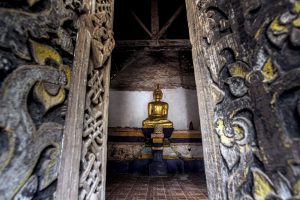
With over five thousand Buddhist temples in Laos, the Theravada Buddhist tradition is deeply embedded in the local culture.
We followed the monks through the streets of Vientiane, passing by a hotel decorated with fancy Christmas lights and decorations. By the hotel corner, the monks lined up to chant sutras and give their blessings for the local people who were kneeling to make offerings to the monks. The monks' chanting and blessings against the backdrop of the blinking Christmas lights presented a unique blend of religions and cultures.
Before I set out on my trip, several people asked me where Laos was and whether the world-renowned Temple of Angkor Wat is located in the country. I only replied by saying that Angkor Wat is located in Cambodia, which is Lao's neighboring country. I also added that one of Laos' most symbolic architectures is Pha That Luang, a Buddhist stupa located in the capital of Vientiane.
Laos' history and cultural identity can be traced back to the Kingdom of Lan Xan in the 14th century, which reigned as a unified kingdom for over three centuries. In 1893, Laos came under French rule for nearly six decades until it gained independence in 1953 and established a constitutional monarchy. A civil war broke out between royalists and communist forces, which ended in 1975 with the overthrow of the monarchy by the communist group. The country then became a socialist state, officially named the Lao People's Democratic Republic.
Agriculture is the mainstay of Laos, but without a railway system to support the export of agricultural products, the country's economic development has been hindered. Laos' tourism is also not as developed as its neighboring countries of China, Cambodia, Thailand, and Vietnam.
However, things are changing in Laos. The China-Laos railway between Yunnan Province's Kunming and Laos' Vientiane is under construction. As part of the Pan-Asia railway network that would link China directly to Thailand, Malaysia, and Singapore, the construction of the high-speed rail will bring many opportunities to Laos.
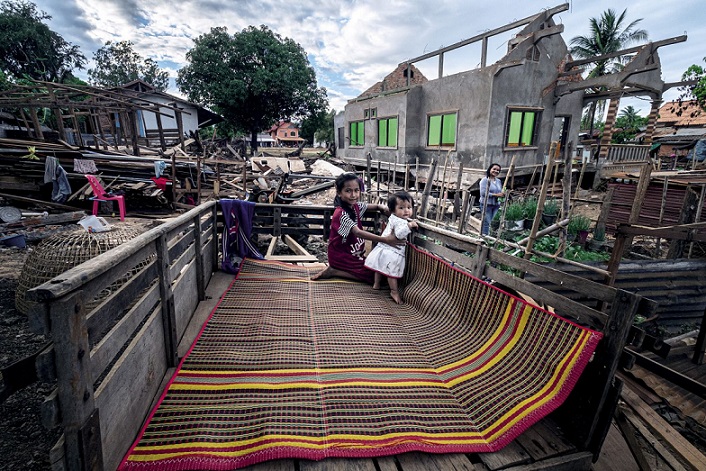
In Sanasomboun District of Champassack Province, local people slowly rebuild their lives after their homes have been destroyed by the floods in 2019.
At the Laos border with Thailand, the Thanaleng station will become the largest railway station in Laos. Anticipating the development and business opportunities that the high-speed rail will bring, a special economic zone is planned to be built by the station.
Yet, in spite of the country's projected development and economic growth, people living in the remote and rural areas of Laos still live in lack and poverty.
My stay in Laos for eighteen days was filled with all kinds of interesting experiences. The local children's tender smiles and the countryside's clear blue skies made me want to stay longer. My friend was right. After coming to Laos, I have fallen in love with this place. I only hope that the flood survivors can recover soon from the disaster, and that in the years to come, may the rainy season bring nourishing rains rather than damaging floods.
Contact Us | Plan a Visit | Donate
8 Lide Road, Beitou 11259, Taipei, Taiwan
886-2-2898-9999
005741@daaitv.com
©Tzu Chi Culture and Communication Foundation
All rights reserved.
